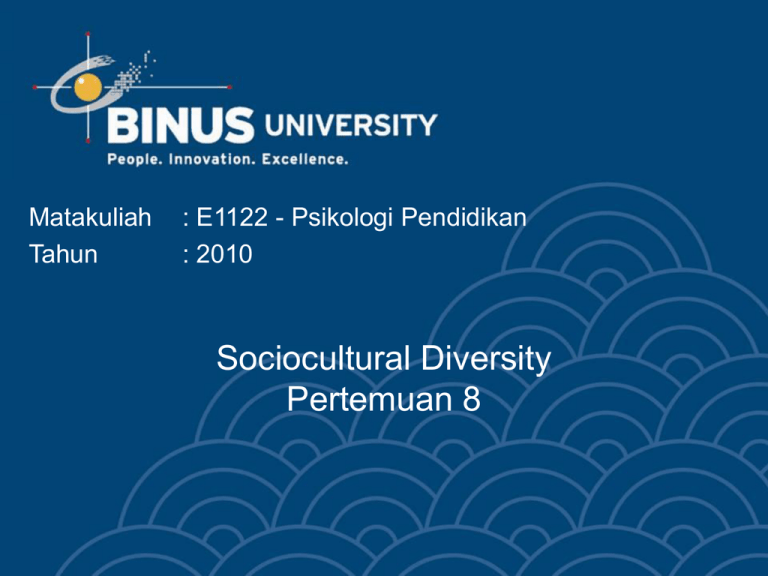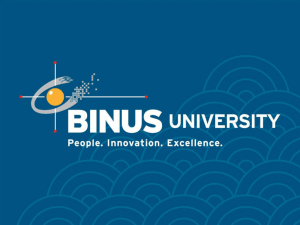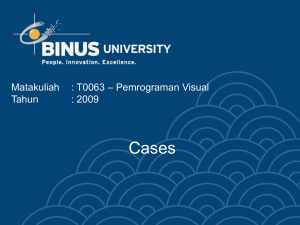Sociocultural Diversity Pertemuan 8 Matakuliah : E1122 - Psikologi Pendidikan
advertisement

Matakuliah Tahun : E1122 - Psikologi Pendidikan : 2010 Sociocultural Diversity Pertemuan 8 Culture • Culture: The behavior patterns, beliefs, and all other products of a particular group of people that are passed on from generation to generation. • Cross-cultural studies: Studies that compare what happens in one culture whit what happens in one or more other cultures, they provide information about the degree to which people are similar and to what degree behaviors are spesific to certain cultures • Individualism, A set of values tht give priority to personal rather than to group goals • Collectivism: A set of values that support the group Bina Nusantara University 2 Socioeconomic status (SES) • Socioeconomic status: the categorization of people according to their economic, educational, and occupational characteristics • In United States SES has important implications for education. Low – SES individuals often heve less eduction, less power to influence a community’s institutions (such as school), and fewer economic resources. Bina Nusantara University 3 Ethnicity • Ethnicity: A shared pattern of characteristics such as cultural heritage, nationality, race, religion, and language. • Ethnicity and School; • Prejudice, discrimination, and bias • Diversity and differences Bina Nusantara University 4 Bilingualism • Learning a second language; learning secong language is easier for children than for adolescents or adults. Adult make faster initial progress, but their eventual success in the second language is not as great as children’s. • Bilingual education: teaching academic subject to immigrant children in their native language while slowly teaching English. ; Bina Nusantara University 5 Multicultural Education • Multicultural Education : Education that values diversity and includes the perspectives of a variety of cultural proups on a regular basis. • Empowerment, providing people with intellectual and coping skills to succed and make this a more just world • Culturally Relevant Teaching, a good teacher are aware of and integrate culturally relevant teaching into the curriculum because it makes teaching more effective • Issues-Centered Education, in this approach, students area taught to systematically examine issues that involve equity and socail justice. They are not only clarify their values but also examine alternatives and consequences 6 if they take a particular stance on an issue. Bina Nusantara University Improving Relations Among Children From Different Ethnic Groups • The Jigsaw Classroom, a classroom in which students from different cultural backgrounds cooperate by doing different parts of a project to reach a common goal • Positive personal contact with others from different cultural background relation improve when students talk with each other about their personal worries, success, failures, coping strategies, interests, and so on. • Perspective Taking Execises and activities that help students see other people’s perspectives can improve interethnic relations Bina Nusantara University 7 Improving Relations Among Children From Different Ethnic Groups • Critical Thinking and Emotional Entelligence Students who learn to think deeply and critically about interethnic relations are likely to decrease their prejudice and stereotyping of other. • Reducing Bias The antibias curriculum argues that although differences are good, discriminating against someone is not. It encourages teacher to confront troublesome bias issues rather than covering them up • Increase Tolerance • The school and community as a team Bina Nusantara University 8 The Issue of Whether a core of “White” values Should be Taught • All students should be tought a set of core values (mutual respect, individual right, tolerance of differences) • All students should be taught a common core or cultural knowledgeto ensure that they become “culturally literate”. Bina Nusantara University 9

